
Dr Ethayaraja Mani
Professor
Chemical Engineering, IIT Madras
Dr Ethayaraja Mani
Research Areas
Molecular simulations, self-assembly, mathematical modeling
People
Post Doc
Phd Scholars
Post Graduate Scholars
Project Assosiate
Research
Pickering emulsions
Emulsions (PE), are liquid-in-liquid dispersions stabilized by particles adsorbed at the liquid-liquid interfaces. These type of emulsions have received ample attention for their potential applications in drug delivery, food formulations, cosmetics, porous materials, catalytic reactions and enhanced oil recovery. Compared to surfactant-stabilized emulsions, PE have superior features such as prolonged stability and tunable permeability. Depending on specific applications, stabilization of PE as well as their destabilization are desired. For instance, during the extraction of crude oil from reservoirs, oil-in-water or water-in-oil emulsions is formed. Breaking of emulsions into immiscible bulk phases (destabilization) is required for separation of oil. Similarly, catalytic particle-stabilized PE are important in the chemical reactions involving biphasic systems due to the availability of high interface area. At the end emulsions need to be destabilized to recycle the catalyst and separate the final product. In this project we use unconventional methods to induce destabilization of PE using additives that are mutually soluble in water and oil. We carry out a detailed experimental and computer simulation study to fully comprehend the mechanism underlying destabilization of PE.

Rheology of polymer-nanoparticle
Telechelic polymers are used as rheology modifiers in many applications such as paints, paper coatings and DNA sequencing. In particular, hydrophobically modified ethylene oxide urethane (HEUR) polymers are commercially used as rheology modifiers in water-borne paints. HEURs are non-ionic telechelic polymers with hydrophobic moities at the ends, which are typically Cn alkanes. The hydrophobic attraction strength can be increased by increasing the number of carbons in the alkane. HEUR polymer end groups adsorb on latex particles in configurations analogous to those in telechelic micelles: loops, where both ends are adsorbed onto the same particle; bridges, where the ends adsorb on two different particles; and dangling with one end adsorbed and the other end free. Furthermore, there could be “free” polymer chains isolated in solution or forming HEUR forming micelles. For latex-HUER suspensions, shear thinning behavior and the dependence of viscosity on hydrophobe length were found to be analogous to the behavior of solutions of HEUR micelles but without the shear thickening regime, for a fixed volume fraction of latex particles and HEUR polymer concentration. We carry out coarse-grained Brownian dynamics simulations of shearing flow of a colloidal suspension bridged by telechelic polymers with “sticky” end groups by treating the polymer as either a finitely extensible dumbbell or a three-bead “trumbbell.” This study provides the first mesoscale simulations of these suspensions, useful for assessing and improving constitutive equations for these suspensions.
Ref: Mani et al., Journal of Rheology (under review)

Aggregation of amyloid β protein
Plaques of amyloid beta (Aβ) protein are associated with neuro- degenerative diseases, and preventing their formation and dissolution of plaques are essential to the development of therapeutics. Nanoparticles (NP) are known to inhibit amyloid fibrillation. The nominee uncovered the role of the surface charge of NP from experimental and computational study: if the residues corresponding to the β-sheet are charged, addition of oppositely charged NP should inhibit fibrillation, irrespective of the material composition of the NP. The kinetics of inhibition follows the predictions of the detailed kinetic model developed in house and molecular dynamics simulations. It is demonstrated that gold nanorods (AuNRs) and silver triangular nanoplates (AgTNPs) could inhibit the formation of Aβ fibrils and that their shape-dependent plasmonic properties could be exploited to dissolve Aβ fibrils. As AuNR absorb near-infrared (NIR) light and creates hotspots, NIR laser applied for 2 min facilitated the thermal dissolution of mature Aβ fibrils. The study provides new insights to design plasmonic nanoparticle-based therapeutics to cure neurodegenerative diseases.

Synthesis of nanoparticle and modelling
The main aim of the project is to control the growth of anisotropic gold nanoparticles (AuNP) using a complementary approach that combines experimental and multiscale modelling methods for both batch and continuous processes. We aim to synthesize anisotropic Au NPs using a seeded growth protocol in the presence of binary surfactant mixtures using batch and continuous methods and study their growth kinetics experimentally. We combine equilibrium thermodynamics and transport models with experimental data develop process models that capture the anisotropic growth of Au NPs and so enable the rational design of batch and continuous experiments. In particular, we study the adsorption of CTAB/DDAB surfactants on quasi-spherical crystalline Au seed particle on its different crystal planes using Molecular Dynamics (MD) simulations. The free energy of a given facet is in turn affected by the surfactant adsorption energy and coverage, and the initial surface energy before any passivation. The equilibrium coverage is regulated by the adsorption energy and the environment (surfactant concentration, temperature). For comparison, simulation is also done on adsorption of CTAB on flat planes, corresponding to adsorption on bulk Au surface. Hence, a study into the dependence of coverage and the initial positions of the surfactants, also taking into account the adsorption energy per unit area might explain a route to control the anisotropic growth of the Au NPs.
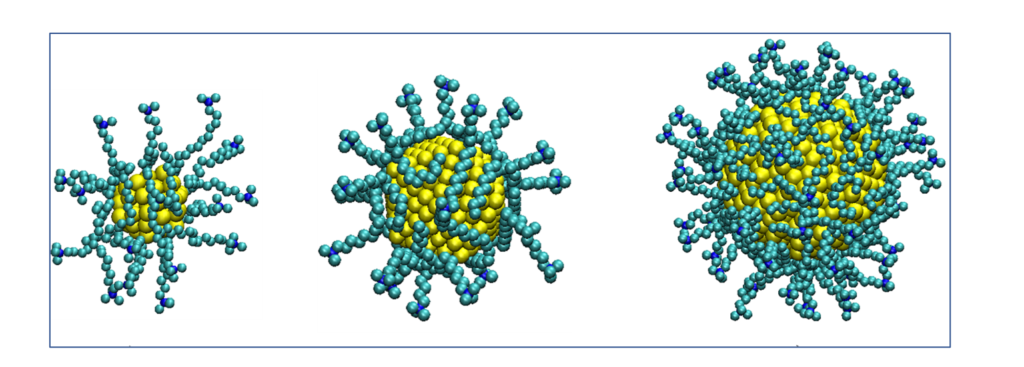
Collective dynamics of active particles
Non-spherical self-propelling colloidal particles offer many possibilities for creating a variety of self-propelling motions mimicking the dynamics of bacteria. The nominee found a transition from linear to circular motion in active spherical-cap particles near a substrate. These particles were first synthesized in the nominee’s lab. Self- propulsion is induced by self-diffusiophoresis by catalytic decomposition of hydrogen peroxide (H2O2) on one side of the particle. Asymmetric distribution of reaction products combined with the asymmetric shape of the particle gives rise to two types of motions depending upon the relative orientation of the particle with respect to the underlying substrate. The study demonstrated the use of non-spherical particles to create linear and circular motion by varying the fuel concentration. We use Brownian dynamics simulations with and without hydrodynamic interactions to study the aggregation behavior of active colloids as a function of activity, interaction and rotational diffusivity.

Self-assembly of patchy colloids
Colloidal particles have been used as an experimental model system to study various features of phase behaviour such as self-assembly, gelation, and crystallization. Attention has been given toward the synthesis of spherical and anisotropic colloids with different surface functionalities, commonly known as patchy particles. These particles mimic shape and directional interactions of molecules and permit the study the formation of diverse varieties self-assembled structures. Several type of these colloidal particles were designed and synthesized in the nominee’s lab. Further self-assembly of some of these colloids are shown in Figure below: controlled assembly of gold nanoparticles (a) and gold nanorods (b) on colloids as rings, staggered assembly of spherical-cap colloids (c) and one-dimensional assembly of bipolar colloids (d).
Ref: Thomas et al., Phys. Chem. Chem. Phys. 2020, 22, 14201 – 14209. Shelke et al., Langmuir 2017, 33: 6760 – 6768. Sabapathy et al., Phys. Chem. Chem. Phys. 2017, 19, 13122 – 13132.
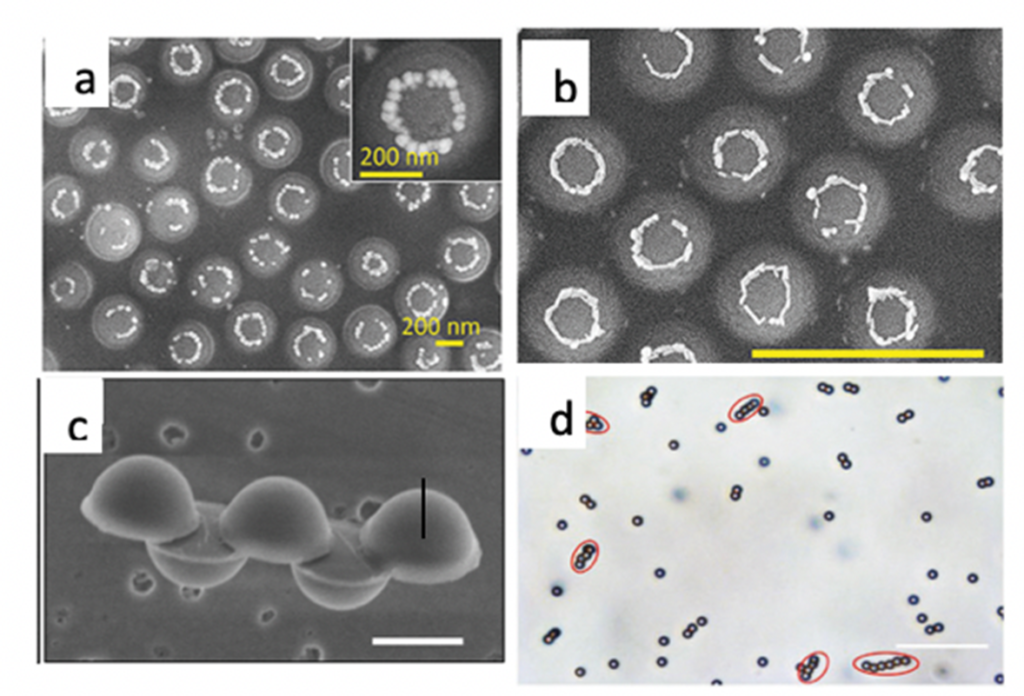
Projects
1. Simple technique for assembly of ‘Nanorods’
https://www.vigyanprasar.gov.in/isw/Researchers-develop-simple-technique-for-assembly-of-Nanorods.html
2. The Benefit of Seawater for Energy Recover
https://tech-talk.iitm.ac.in/the-benefit-of-seawater-for-energy-recovery/
Facilities
- Hot air oven – Use dry heat for sterilization and heat treatment.
- Fluorescent spectrophotometer – Analyze fluorescence from the sample
- Homogenizer – Homogenize and create consistent mixture.
- Dip coating unit – Dip coating for liquid resists
- Laminar hood – Work bench to create contamination free work environment.
- Thermal Metal Evaporator – It is used to induce metallic coating over substrates by converting thin metal wires into vapours using extreme heat.
- Fluorescence microscope – Has magnification power of 100X and enabled with fluorescence imaging.
Instruments
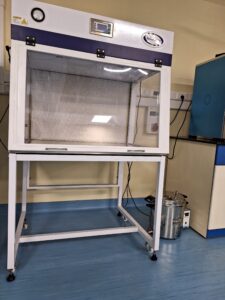
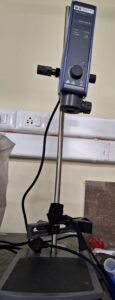
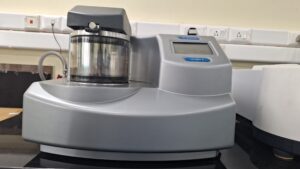
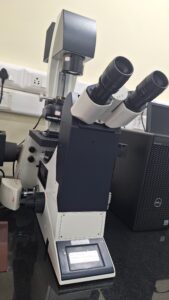
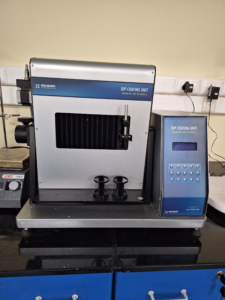
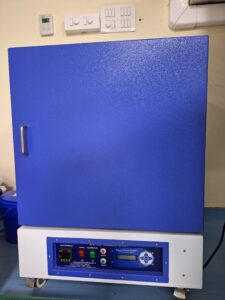
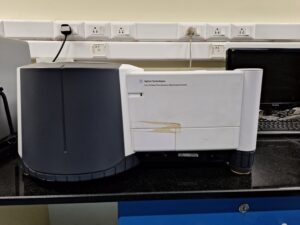
Collaboration
- Dr. Ronald G. Larson – University of Michigan, USA
- Dr. Sanat K. Kumar – Columbia University, New York, USA
- Dr. Sulalit Bandyopadhyay – Norwegian University of Science and Technology (NTNU), Trondheim, Norway
- Dr. Hajime Tanaka – The University of Tokyo, Japan
- Dr. Saji George – McGill University, Canada
Publication
- Demulsification of Pickering Emulsions by Chemical Dissolution of Stabilizers RS Gohil, S Karishma, H Kumar, MG Basavaraj, E Mani Langmuir 2024
- Effect of biopolymer concentration on the kinetics of marine snow formation TR Akshaya, S Sudhakar, E Mani, K Murali Deep Sea Research Part I: Oceanographic Research Papers 207, 104291 2024
- Molecular Dynamics Study on the Rheology of Polymer-Nanoparticles Mixture: Role of Inter-particle Interactions SR Kalghatgi, S Kumar, E Mani Bulletin of the American Physical Society 2024
- Design and modeling of sub-micron particles via precipitation B Sulalit, E Mani Academic Press 2023
Liquid–Liquid Phase Separation (LLPS)-Driven Fibrilization of Amyloid-β Protein S Sudhakar, A Manohar, E Mani ACS Chemical Neuroscience 14 (19), 3655-3664 2023 - Oil-in-Water Emulsions Stabilized by Hydrophilic Homopolymers S Karishma, K Rajvanshi, H Kumar, MG Basavaraj, E Mani Langmuir 39 (38), 13430-13440 2023
- Microfluidic Investigation of Surfactant-Assisted Functional Silica Nanofluids in Low-Salinity Seawater for Enhanced Oil Recovery Using Reservoir-on-a-Chip G Kumar, E Mani, JS Sangwai Energy & Fuels 37 (14), 10329-10343 2023
- Impact of surface-modified silica nanoparticle and surfactant on the stability and rheology of oil-in-water Pickering and surfactant-stabilized emulsions under high-pressure G Kumar, E Mani, JS Sangwai Journal of Molecular Liquids 379, 121620 2023
- Destabilization of Pickering emulsions by interfacial transport of mutually soluble solute H Kumar, S Upendar, E Mani, MG Basavaraj Journal of Colloid and Interface Science 633, 166-176 2023
- Electrostatic heteroaggregation: fundamentals and applications in interfacial engineering N Madhavan, AP Deshpande, E Mani, MG Basavaraj Langmuir 39 (6), 2112-2134 2023
- Time gel and origin of matter R Sen, S Paul, S Krishnamurthy, A Devi, E Mani, RJMK Gebbink, S Roy Journal of the Indian Chemical Society 100 (2), 100897 2023
Social Impact
Content need to be added
Gallery
Content need to be added














